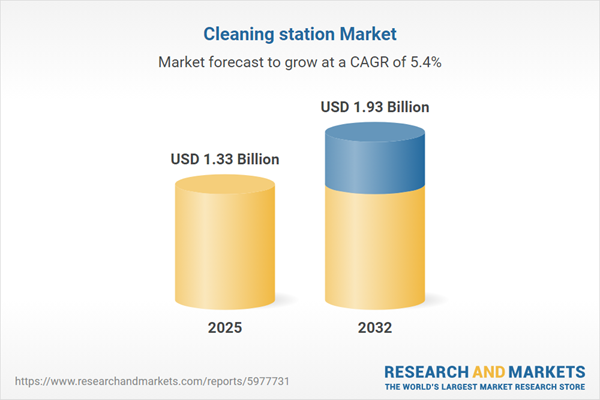Speak directly to the analyst to clarify any post sales queries you may have.
The cleaning station market is at the center of a global shift as organizations prioritize higher hygiene and productivity standards across industrial and commercial environments. Senior executives require actionable intelligence to align investments with evolving industry drivers, regulatory imperatives, and customer expectations.
Market Snapshot: Cleaning Station Market Growth at a Glance
The global cleaning station market grew from USD 1.26 billion in 2024 to USD 1.33 billion in 2025. The sector is projected to maintain momentum at a CAGR of 5.44%, reaching USD 1.93 billion by 2032. This trajectory is underpinned by adoption of advanced automation, digitalization, and sustainable cleaning solutions as organizations emphasize regulatory compliance, operational efficiency, and reduced environmental impact.
Scope & Segmentation of the Cleaning Station Market
This report provides in-depth coverage across key market dimensions, technologies, and end-user contexts:
- Type: Automatic (aerial, conveyorized, walk-in); Manual (handheld, stationary)
- End User: Automotive (aftermarket, OEM), Food and Beverage (bakery, beverage, dairy), Healthcare (clinics, hospitals), Manufacturing (chemical, electronics, machinery), Pharmaceutical (API manufacturers, generic drug producers)
- Distribution Channel: Offline (direct sales, distributors, retailers), Online (company websites, e-commerce platforms)
- Application: Degreasing (aqueous, solvent-based), Precision Cleaning (ultrasonic, vapor degreasing), Surface Cleaning (equipment cleaning, parts cleaning)
- Material: Plastic (polyethylene, polypropylene), Stainless Steel (304 Grade, 316 Grade)
- Regional Coverage: Americas (United States, Canada, Mexico, Brazil, Argentina, Chile, Colombia, Peru), Europe Middle East & Africa (United Kingdom, Germany, France, Russia, Italy, Spain, Netherlands, Sweden, Poland, Switzerland, United Arab Emirates, Saudi Arabia, Qatar, Turkey, Israel, South Africa, Nigeria, Egypt, Kenya), Asia-Pacific (China, India, Japan, Australia, South Korea, Indonesia, Thailand, Malaysia, Singapore, Taiwan)
- Key Companies: Alfred Kärcher SE & Co. KG, Nilfisk A/S, Tennant Company, Hako GmbH, Ecolab Inc., Diversey Holdings, Ltd., Comac S.p.A., IPC Eagle, Inc., Minuteman International, Inc., Lavorwash S.p.A.
Key Takeaways for Cleaning Station Market Decision-Makers
- Industry transformation is driven by automation, smart monitoring, and the adoption of eco-conscious cleaning solutions that address stricter regulatory environments.
- Digitalization enables real-time process monitoring, predictive maintenance, and increased equipment longevity, enabling organizations to lower operational risk and extend asset life.
- Collaborative robotics and modular configurations offer flexibility for diverse production settings, from high-mix manufacturing to sensitive healthcare and food processing operations.
- Procurement strategies increasingly focus on the total cost of ownership, with demand for solutions that minimize solvent use and waste while ensuring compliance and traceability.
- Regional markets exhibit unique drivers: North America is influenced by regulatory standards and robust supply chains, EMEA prioritizes precision and hygienic design, while Asia-Pacific is shaped by rapid industrial growth and emerging sustainability trends.
Tariff Impact: 2025 U.S. Policy Developments
New tariffs introduced by the U.S. in 2025 have reshaped supply chains for cleaning station suppliers, increasing costs for imported precision components and electronics. To mitigate these pressures, industry participants have accelerated nearshoring efforts, invested in domestic assembly, and sought contractual flexibility with both upstream partners and downstream customers. Industry associations have engaged regulators to advocate for relief measures. These adjustments have not only changed cost structures but have encouraged innovation in procurement practices and international collaboration.
Methodology & Data Sources
This analysis is built on a multi-phase research approach, starting with an extensive review of sector publications and regulatory documents. It is supplemented by over fifty primary interviews with manufacturers, end users, distribution partners, and regulators, and validated through expert workshops. Data triangulation ensures robust, actionable insights tailored for industry stakeholders.
Why This Report Matters for Senior Decision-Makers
- Gain timely, segmented insights to support strategic planning, product development, and market entry or expansion initiatives.
- Understand technology, supply chain, and sustainability trends shaping purchasing decisions and vendor partnerships.
- Identify actionable levers for operational resilience, procurement risk mitigation, and future-ready investment within your organization.
Conclusion
The trajectory of the cleaning station market is shaped by rapid advances in automation, digitization, and sustainable technology. This report provides the granular perspective required for senior leaders to navigate future shifts and drive excellence in both investment and operations.
Additional Product Information:
- Purchase of this report includes 1 year online access with quarterly updates.
- This report can be updated on request. Please contact our Customer Experience team using the Ask a Question widget on our website.
Table of Contents
3. Executive Summary
4. Market Overview
7. Cumulative Impact of Artificial Intelligence 2025
Companies Mentioned
The companies profiled in this Cleaning station market report include:- Alfred Kärcher SE & Co. KG
- Nilfisk A/S
- Tennant Company
- Hako GmbH
- Ecolab Inc.
- Diversey Holdings, Ltd.
- Comac S.p.A.
- IPC Eagle, Inc.
- Minuteman International, Inc.
- Lavorwash S.p.A.
Table Information
| Report Attribute | Details |
|---|---|
| No. of Pages | 188 |
| Published | November 2025 |
| Forecast Period | 2025 - 2032 |
| Estimated Market Value ( USD | $ 1.33 Billion |
| Forecasted Market Value ( USD | $ 1.93 Billion |
| Compound Annual Growth Rate | 5.4% |
| Regions Covered | Global |
| No. of Companies Mentioned | 11 |









